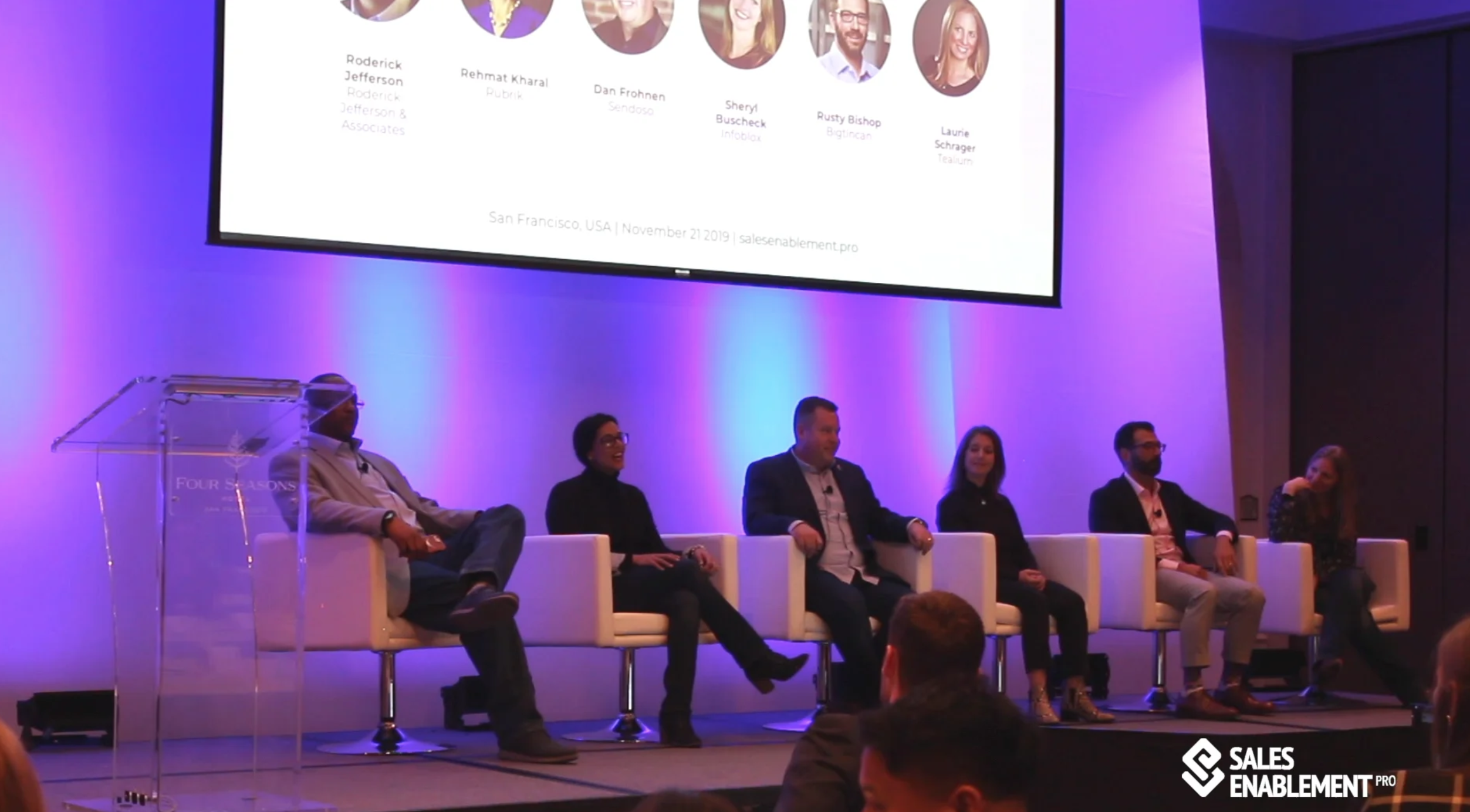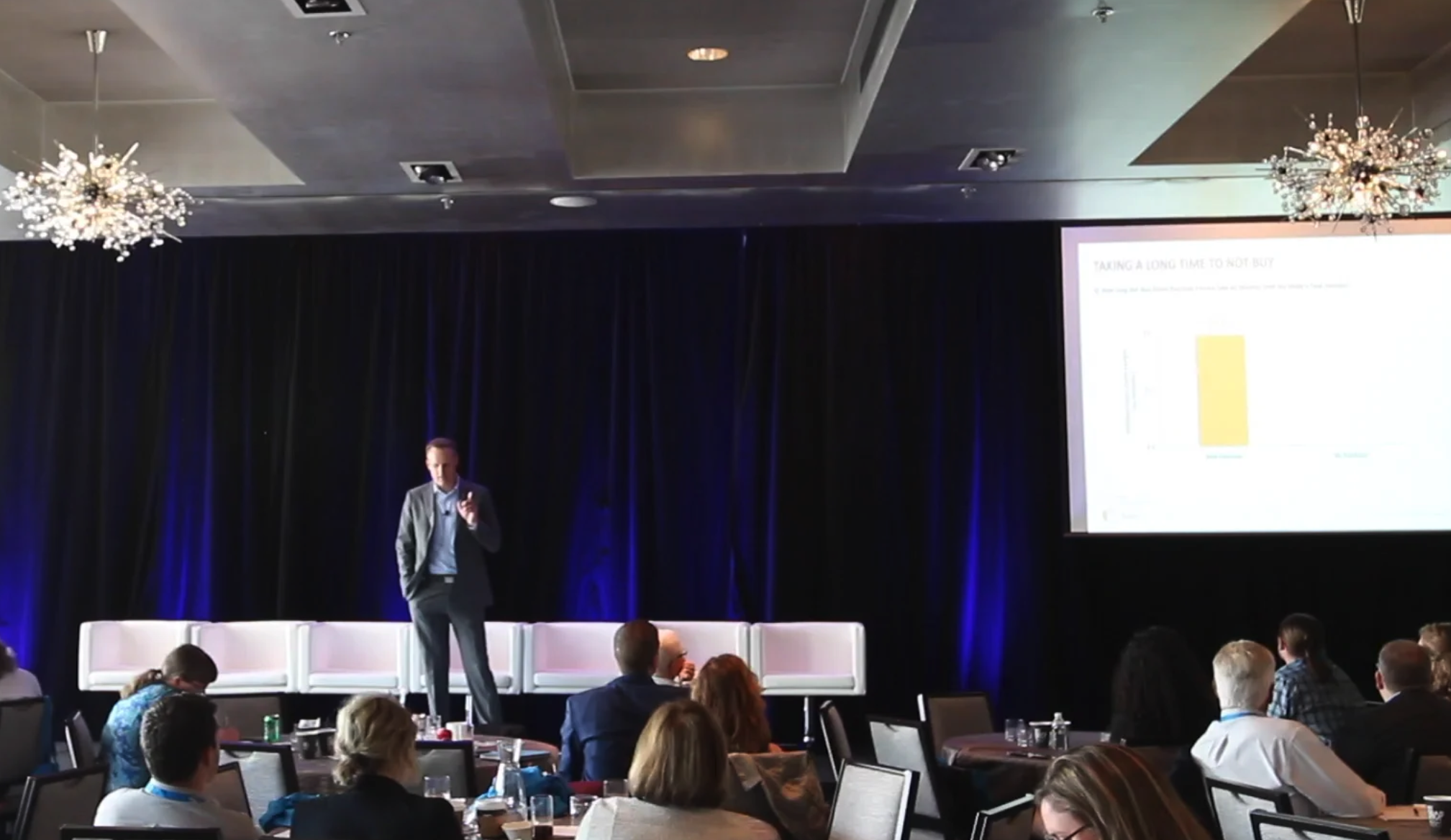Shawnna Sumaoang: Hi, and welcome to the Sales Enablement PRO Podcast. I’m Shawnna Sumaoang. Sales enablement is a constantly evolving space, and we’re here to help professionals stay up to date on the latest trends and best practices so that they can be more effective in their jobs.
Today, I’m excited to have Kate Munday from Google join us. Kate, I would love for you to introduce yourself, your role, and your organization to our audience.
Kate Munday: Thank you so much for having me. A bit about what I do, I help transform people and brands by educating them on how to communicate their stories effectively. I’m a communications coach, I’ve got my own company, Out The Box Speakers, and I’m also a creative business partner for Google.
I’ll just elaborate on that cause I think it’s really funny and ironic really that I am in communications and storytelling. I’ve always really loved storytelling, but communication has been something that I used to really struggle with. To tell you a little bit more about that, speaking particularly was my number one fear. I always talk about how it’s funny, I’ve turned my fear into my career. It has basically been a long journey from being very much an introverted individual born into this big family of extroverts who didn’t understand me. I am also dyslexic, and like I said, just shied away from communication a lot growing up.
It was only then really getting into the working world that I started to really understand the importance of it and how much it could do for me if I was able to master this skill of communication. It’s really been a bit of a whirlwind, a bit of a journey, but it was nine years ago that I joined Google and that’s when I joined our sales organization and since then they’ve really given me a platform to educate myself and now to help educate others in storytelling and speaking.
I mostly coach and I work with our brands, but in terms of individuals, it tends to fall within three buckets. It’s like people who want to speak for themselves, so that’s either getting up on stage or radio, or even podcasts, or they want to perhaps climb the corporate ladder, so they can get a promotion at work and they understand that communication is going to be a really important factor to that, or perhaps they want to, like we’re talking about now, become better sellers, communicate their products or services more effectively as well.
SS: From one introvert to another, I am excited to have you here on the podcast. Now, you talked a lot about storytelling in your introduction, and it is one of your key areas of expertise. To start, I’d love to understand from your perspective, why is storytelling so critical in sales.
KM: I guess to give you an idea, I started with Google nine years ago in our sales team, and of course, Google is known for our masses of data. That’s how I started selling. It’s like this actually makes sense for somebody then surely they should buy the product or service that we’re offering, but that’s not quite the case. Throughout those nine years, I have come to recognize that actually, of course, we are emotive beings when we make decisions, we feel something first, like how does that make me feel, and that’s why advertising works. We play into love and fear, these two big emotions, and then we rationalize something.
When we are telling somebody facts and figures, it only ignites two different parts of a person’s brain, whereas if you start to tell a story and you play into those emotions, you start to ignite seven different parts of their brains. There’s proof in the pudding there, that’s why storytelling is so important. It helps us relate and connect to other people, to products, and to brands. That’s really what we want. We want that connection. We want to feel like somebody understands us and our needs and they’re going to deliver an effective solution for us. In selling, a key part of that is relationships, isn’t it? Storytelling and relationships where we know these all go hand in hand. Even if we are out with our friends, with storytelling, with our partners, we’re at work, we’re constantly telling stories. It’s a critical part of sales.
SS: Absolutely. I couldn’t agree more. Kate, what would you say are some common mistakes that sellers might make when they’re trying to convey value to buyers and how can better storytelling help them overcome these challenges?
KM: I think, first of all, not hooking your audience in the first place, so it really is when we speak, people really only care about what’s in it for them, to be honest. They just want to know how to be better or they say tell me what I need to know to not make the mistakes you’ve made or to actually be successful, or whatever it is. It’s how we add value to someone’s life. I think that’s the very first thing that we need to do, is to call that out, like this is what I can improve your life and make it look however you want it to look.
That initial hook and I talk about there are multiple different hooks in the first stages. Even the title of your email is also a hook. The title of your speech, the very first words that exit your lips, because it actually takes five seconds, and that’s why the skip button on YouTube is after that five seconds because that’s the amount of time it takes somebody to decide whether they’re going to actually listen to you or not. I think that is one of the most common mistakes, people get excited, don’t we? We just get away with ourselves and start speaking, but it’s not about you as a seller or a speaker, it’s about your audience and it’s about how you can help them. I think delivering value first is really important. That’d be my first one.
Then I’d say that we get into this trap of highlighting features rather than benefits, and again, it comes back to that added value, doesn’t it? We’re really good at listing off, oh, you know, it does this, it’s shiny, it’s cool, it has all these fun things, but look, what does that mean? What’s the reason behind that? Yes, okay. It might be shiny, but what does that mean to someone’s life? How can that make it better?
The next one I’d say, and it’s going back to that relationship, it’s that relatability and that connection really throughout my sales career, I don’t really see it as selling. I’m just connecting with people and helping them and building relationships, and actually, somebody said this to me at a networking event the other day, and they said that the difference between contracts and contacts is the letter R, which stands for relationships. I really do think that you can’t get those contracts without having good contacts, which you have great relationships with.
The way that we can build better relationships with our clients is through storytelling. It’s about opening up, letting them in, showing them that you are a real human person just like them and that you perhaps have things in common and you can start to build those relationships and those connections and then the selling comes later. People do business with people and they’ll invest in you as a person before the product or service or future that you are about to tell them. They’re my three things. The hook at the start, highlighting the benefits again and delivering value, and then it’s about relationships.
SS: I think those things are absolutely critical in good storytelling. On that note, I would also love your advice because we are looking into understanding what good looks like. What does good storytelling look like in sales? In other words, what are some key best practices that sellers should leverage in their conversations with buyers?
KM: What does good storytelling look like in sales? So I guess there are all these common patterns. It depends on what that selling looks like and what platform you’re using. Is it a presentation or a podcast or a video? Whatever that looks like, of course, you’re going to tweak the way that you actually tell that story and be intentional about what part of that story you are telling, but I think again, to reiterate, to start off with, it’s really about why they should care on the very first instance, and that being upfront and center.
If we think about a normal pitch and how that goes, the first thing is hooking them in. Why should you listen? Then we kind of pre-frame them, so we talk about that’s why we set agendas, we are using the adult learning theory. This is what I’m gonna tell you, so perhaps again, if we think about it, that’s why you introduce characters. You set the scene, don’t you? You’re preparing people for what they’re about to receive. If this is a presentation, it’s like different from a video perhaps, but if it’s a presentation, then you might go into explain why you are the best person to deliver that information to them and that you are an expert and you do really care and you’re there to help them, and that’s the problem that you’re going to solve for them today.
Then you get into obviously the crux of the story. That’s when you actually can start to uncover things and we call that a Google the messy middle. In the end, you’ll come to some quiet kind of resolution or conclusion toward the end, but really, I think there are many different ways in which you can tell that story, it’s just really understanding what is the objective, I think first and foremost, or what is the story that you want to tell to them. How do you want them to feel, think, and do out the back of you telling that story? Is it that you want them to make a purchase or is it just that you want them to actually give them some information so they’re a bit more knowledgeable on something?
Of course, that story might look slightly different depending on what the objective is and then, what’s the right format as well to tell that story, so is it perhaps quite a bit longer educational piece or is it actually just something that’s quite quick that you might be able to deliver in a video or a quick explanation, so it’s really understanding, again, the use case for it. Going back to that objective, how you deliver that in the most impactful way, then it really is about bringing them on the journey with you again.
Don’t go after the money necessarily. I think that’s really important. I think if you are doing the right thing for the customer, that’s the most important thing. That’s number one. You have to be passionate about what you are selling I chose to work for Google because I think it’s a fantastic organization. I believe in the product, so it was easy to sell for me because it just came naturally and that’s it. When you are passionate, like passion’s, infectious, people love it when you’re passionate, they just want to hear more from you. I think if you go after your passion and you are true to yourself, then money will flow. If you’re doing the right thing and you’re being passionate, then bring them on that journey with you. Be really open and honest with them. Be human, be relatable, and I think the sales will speak for themselves.
SS: I love that. I think that’s a fantastic description of what good storytelling looks like. What role does sales enablement specifically play in helping sellers improve their storytelling?
KM: It really is about educating people through this sales process and I think we are natural storytellers. Storytelling and sales come hand in hand. We are natural storytellers. This is nothing new. Whether we were carving into caves back in the day or drawing with all forms of storytelling. However, of course, we can all be better at these things as well. I think I’m living proof that it’s not something that came naturally to me speaking. I did enjoy storytelling. Was I good at it? I think it’s definitely been a working progress. I’ve currently got nine coaches the moment, and some of the biggest businessmen and women have many different coaches there’s a good reason for that modeling behaviors, learning from people who have been through that and have been successful in something and are then passing on their knowledge is important.
That’s something that I implore you to do if you haven’t already got a coach, go and get one. Set out your objectives, and what you want to learn, and achieve with them and make sure you see that through. I think that the first thing is taking accountability and saying, yes, you know, I want to be better at this. Second of all, then actually taking action on that and doing it is always the first time that you do something is the hardest, then when you keep doing it, it becomes easier and easier, and it’s that repetition. The more stories that you tell, the more that you speak, the more that you sell, the easier it becomes.
Obviously, then you start to perfect it. You start to become better and better at it, and it becomes more natural. It’s like riding a bike. The first time you get on it, you might fall off, and then it becomes something that is just automatic. You get on, you don’t even think about it because you’re just a natural. I do implore not just organizations to lean into storytelling and understand the importance of that in selling and communication, but also the individual. As you, yourself, take ownership of your own career, of your own life, and, and get a coach, enable yourself.
SS: I love that advice. You have a lot of experience helping brands with their video storytelling strategies. Based on your expertise here, how can sales teams leverage video and other content formats to essentially help them tell a more compelling story to their buyers?
KM: I know that video can be a great tool. It’s a booming platform for pre-recorded content, of course, which could be great too, if you do need to sell it, send over materials perhaps that’s showing them what good looks like or guiding your buyer through a process perhaps that’s an amazing way to engage them and it gives them a nice resource that they can house on their internal sites so they can look back at the content as well. I think in terms of selling, for me personally, real-time selling and if you do have to do that on video, there really are some key ways to do that. I think the thing that we all probably can relate to is when people turn off their cameras on that video call and then you become this little faceless screen that number one you are presenting to, and then also receiving information. It just becomes very inhumane and that’s what we want to try and get away from.
One of the things I do is in every meeting I really do try and build in a good five to 10 minutes at the start to break down those walls of communication and get that flowing. It’s all really about leading with vulnerability for me and letting people in to show them that I am a human and how can I get somebody to connect and resonate with me as quickly as possible.
I do lots of things around the setup at home and what’s in my background, so I think that the setup around you is a great opportunity to show people different facets of you. I’ll put objects on the shelf behind me that have great stories or that show a reflection of my personality and often people say, oh, what, yeah, what is that behind you? And then it starts a really great good opportunity to tell the story. People do comment on that actually and then you get to tell them the story and then once you get them laughing and then their barriers are broken down and that’s when you can leave them with something memorable that they’ll remember you by, but also perhaps they’ll say, oh the same thing happened to me, or actually I’ve got a similar story, and then you create that resonance, that connection and that’s where you can get to start to build those relationships.
I’m going back to this time again, but really is about relationship building. That is what sales for me is about. That it can be a little bit more challenging over video sometimes when we’re selling, but actually there are some key differences that we can lean into, like you don’t get that kind of opportunity at work, you have a blank canvas behind you. You don’t get to dictate that, but actually, when you’re at home and you are presenting and selling over a video call, that’s a really unique opportunity that we can utilize.
SS: I think so as well. Last question for you, Kate. I have loved this topic, by the way. This has been extremely informative for me. Your favorite motto is ‘everyone is your teacher’, meaning you can learn something from anyone. To conclude, how do you think this mindset influences how you approach storytelling, and how can sellers apply that mindset to their interaction with buyers?
KM: I think mindset and attitude are everything. To be specific, a positive mindset, and that’s what I really do in all the work that I do, and try to integrate that into everything. The coaching, for example, like I go in there already, having visualized that coaching session being successful. I know it’s going to be transformational for my client. I see them at the end of that coaching session with a big smile on their face, having loved the session, telling me how much they’ve learned and grown through the experience and that’s it. I think it’s going in with that mindset that it’s already going to be a success.
I think going and reframing my clients, I’m their number one fan. I just want to help them succeed and that’s it. It’s about delivering that value, how we help others, and going back to my motto, ‘everyone is my teacher’. It’s because I learn also in these processes, so I’m grateful for these opportunities. Every time I go into storytelling or a selling situation, not only am I able to give back, but I’m learning and growing and developing myself, and it’s a part of my journey. We are living in one big narrative. It’s your narrative. You are the author. This is your book, and you get to make it a really good book that’s worth reading, so why not make it a really fun, positive book and have that attitude?
SS: I love that approach. Kate, thank you so much for joining us today.
KM: Thank you so much. I’m very grateful.
SS: To our audience, thanks for listening. For more insights, tips, and expertise from sales enablement leaders, visit salesenablement.pro. If there’s something you’d like to share or a topic you’d like to learn more about, please let us know. We’d love to hear from you.







